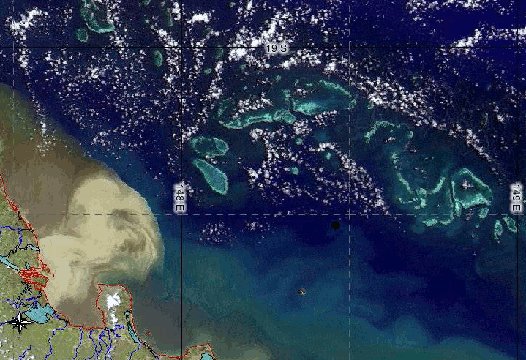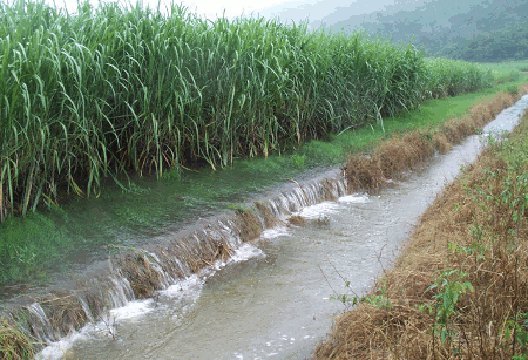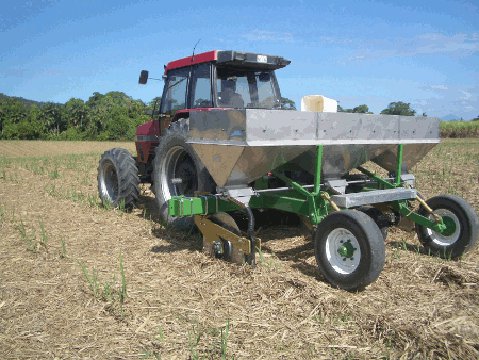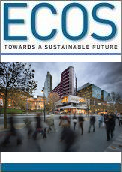
|
Published: 3 October 2011
Catalyst for reef-friendly farming practices
Pollution from farming has contributed to the degradation of Queensland’s Great Barrier Reef ecosystem, reducing its resilience to climate change and other pressures over the long term. Now, a groundswell of support for farming innovations – including a pioneering partnership between a natural resources management1 regional group, the Coca-Cola Foundation, WWF Australia and sugarcane farmers – may turn things around.

|
|
This satellite image shows the brown and aqua colours of a flood plume as sediment flows from Queensland’s Burdekin River into the Great Barrier Reef lagoon. Credit:
NASA/GeoScience Australia/CSIRO
|
While many graziers and farmers within the reef’s catchments are voluntarily adopting ‘reef-friendly’ management practices, the uptake has been too slow to reverse the decline in reef health.
In 2009, to protect what is both a priceless part of Australia’s natural heritage and a $6-billion source of revenue for the Australian economy, the Queensland and Australian governments released a revised Reef Water Quality Protection Plan (Reef Plan), specifying targets to be met by 2013.
The plan’s coordinated program of projects and partnerships is designed to improve reef water quality though better land management in its catchments.
Reef Plan’s ambitious targets include a minimum 50 per cent reduction in nitrogen, phosphorus and pesticide loads entering the reef by 2013 compared with 2009’s pollutant loads. Another target of 50 per cent late dry season groundcover on dry tropical grazing land by 2013 will help meet a longer-term target of 20 per cent reduction in sediment load from catchments by 2020.
CSIRO scientists from the Water for a Healthy Country Flagship Program collaborated with the Queensland Department of Environment and Resource Management and the Australian Centre for Tropical Freshwater Research to estimate the 2009 baseline pollutant loads that will be used to measure progress towards Reef Plan targets.
Their results, published in the Reef Plan’s First Report Card, show that the reef is in moderate condition and some progress has been made since the first 2003 Reef Plan, However, areas of concern include poor seagrass condition in the Mackay–Whitsunday area, and damaged inshore coral reefs in the Burdekin region.
Other findings showed that since European settlement, suspended solid loads have increased at least 5.5 times to 14 000 000 tonnes per year (t/y), total nitrogen loads at least 5.8 times to 66 000 t/y, and total phosphorus loads at least 8.9 times to 14 000 t/y.
Moreover, at least 28 000 kilograms of pesticides are transported to the reef every year. The scientists say the total pesticide load is probably greater, as only certain herbicides were considered in the first estimate.

|
|
Every year, wet season runoff from canefields carries many thousands of tonnes of nutrients, sediment and chemicals into rivers that flow to the reef. Credit:
CSIRO
|
‘We estimated and compared current and pre-European loads across 35 basins in the reef catchment,’ explains Dr Frederieke Kroon, Principal Research Scientist at CSIRO Ecosystem Sciences.
‘By subtracting pre-European from current load estimates, we could then estimate by how much loads had increased due to human activity. It is these so-called anthropogenic (or baseline) loads that we are trying to reduce by improved land management to achieve the Reef Plan’s ambitious targets.
‘We found that these baseline pollutant loads differ significantly across the ten contaminants, 35 basins and six natural resource management (NRM) regions examined,’ says Dr Kroon. She explains that these variations reflect local and regional differences in catchment land use and management, topography, soil characteristics, rainfall and surface runoff.
‘These differences are now being taken into consideration when developing and implementing new land management practices in catchments adjacent to the reef.
‘Importantly, we are also working with graziers and cane farmers to better understand how water quality improvement can be achieved in a cost-effective manner.’
Reef Rescue, Project Catalyst and ‘precision agriculture’
Of the Great Barrier Reef’s approximately 42.5-million-hectare catchment, 74 per cent is subject to cattle grazing, with an additional three per cent (more than one million hectares) intensively cropped.
Programs such as the federally funded Reef Rescue provide incentives to farmers to improve land management practices. The first results of these changes are due in the next Report Card, scheduled for early 2012.
Early indications are good, according to the currently unpublished 2009–10 Reef Rescue report from Terrain NRM, a community-based not-for-profit organisation that administers Reef Rescue projects in the Wet Tropics bioregion. Improved farm management practices and training funded by Reef Rescue in 2009–10 are estimated to have reduced the nutrient load leaving paddocks and entering the reef by almost 757 tonnes, sediment by more than 26 000 tonnes and pesticide by 1.5 tonnes.
Project Catalyst is another initiative encouraging farmers to adopt practices that improve the quality of water leaving their land. Primarily aimed at reducing the impact of pollution from sugarcane production on both river water quality and the reef’s marine ecosystem, Project Catalyst is a partnership between Reef Catchments (the Mackay region's NRM group), the Coca-Cola Foundation, WWF Australia and sugarcane farmers.
The project began in 2009 in the Mackay–Whitsunday region, and has recently expanded to include cane growers in the Wet Tropics and Burdekin regions. It has already won a 2010 Banksia Award and the 2011 Sustainability Partnership category at the Queensland Premier's Sustainability Awards, and is one of two finalists for the prestigious 2011 Australian Riverprize, awarded by the International RiverFoundation.
Project Catalyst provides growers with expert advice and financial support for practices such as controlled traffic2, irrigation efficiency and fertiliser management. In the project’s first year, participants noted improved management of soil, nutrients, pesticides, irrigation and stormwater across almost 5000 hectares of farmland.
‘One of the most interesting things about Project Catalyst is that a majority of the farmers involved in the program were already investing their own money and testing their own ideas,’ says Mr Will Higham, Land and Water Operations Manager at Reef Catchments.
‘Others were keen to try new precision farming practices, which fall into four broad categories.
‘To improve soil management, for example, farmers are trialling GPS-guided machinery that helps reduce damage to the soil through compaction. Once the issue of compaction is controlled, farmers can be much less aggressive with cultivation, resulting in less soil erosion.’
Mr Higham says nutrient pollution is being managed through initiatives such as precision agriculture, which maps soil types and nutrient requirements across a paddock. This allows farmers to use GPS to apply nutrients at variable rates.
‘It puts the nutrients where they’re required, and while it may not change the total amounts involved, it reduces wastage,’ says Mr Higham.
‘Similarly for chemical (herbicide) management, using GPS-guided precision agriculture, particular weeds can be targeted in an area. By employing the latest available technologies, farmers can be more precise about where chemicals are applied.’

|
|
More precisely targeted nutrient application reduces wastage and ensures better results from a given application. Credit:
CSIRO
|
The fourth precision farming category is irrigation management.
‘The Burdekin growing area is fully irrigated, so we are expecting to see a lot of initiatives in that area as Project Catalyst spreads,’ says Mr Higham.
‘In Mackay, we are focused on the best low-pressure overhead systems, with advanced controllers that allow more precise application of water to meet the changing needs of crops at different stages of their growth.’
Mr Higham says that one of the biggest surprises has been the impact of improved soil management on the volume of water running off fields, which has also reduced the nutrient, sediment and herbicide loads in runoff.
‘We expected an impact on the amount of soil coming off, but were pleasantly surprised about its effect on nutrients and herbicides. Meanwhile, nutrient and herbicide activities have also reduced runoff at both the paddock scale and small sub-catchment scale.
‘Reducing the impact of farming practices while maintaining a viable agricultural sector is key to increasing the resilience of not only the reef, but also the communities that depend on its continued health.’
1 Natural resource management regions are based on water catchment or bioregion boundaries. The Australian Government, in association with state and territory governments, has identified 56 regions covering all of Australia.
2 Controlled traffic farming is a system where all field equipment, such as harvesters, is restricted to permanent wheel tracks across a paddock, using the same path for each operation. GPS is often used to steer the machinery and keep it on the precise track. When combined with zero tillage, controlled traffic farming leads to reduced soil compaction (especially when paddocks are wet), more porous soils, higher-yielding crops, and more energy-efficient farming operations.



